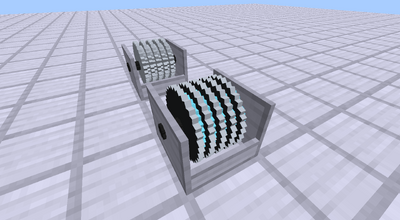
The Industrial Coil is Rotarycraft's primary way of storing mechanical shaft power. There are two types of industrial coils: Steel, which is capped at a maximum storable energy of 720 MJ, with speed and torque both capped at 1024 for a maximum of 1MW power output, and Bedrock, which is capped at a maximum storable energy of 240 TJ, with speed and torque both capped at 4096 for a maximum of 16MW power output.
There is no energy loss in the industrial coil, meaning the amount of energy put into an Industrial Coil will be the same amount that can be taken out. A coil cannot be charged and discharged at the same time. The Industrial Coil will be able to charge from incoming power while not recieving a redstone signal, if a redstone signal is supplied, the Industrial Coil will discharge its stored energy at the specified speed and torque.
This is the best way in early and mid game to move power to machines, when the player cannot provide enough sustained power, torque, or speed to run a machine. An Industrial Coil, when broken with a pickaxe, will drop itself as an item with its current energy charge intact.
An Industrial Coil will output the percentage of current charge over maximum charge from 0-14 sideways through a comparator. The coil fails at 15. Since an Industrial Coil is switched on or off by a redstone signal a crude safety shut off can be created by connecting the inverse of the output from a comparator to the Industrial Coil.
Rotarycraft Handbook Description[]
"The Industrial Coil stores energy in a large spring that can be unwound on command with redstone. Due to the fact that its output torque and speed can be chosen at will within prescribed limits, it can be used to store energy for later or as a sort of capacitor, to store low-power energy accumulated over a long time and then release it in one powerful burst. Note that each coil type has a maximum storage capacity, and that exceeding that will result in an extremely violent release of all stored energy. This machine cannot simultaneously charge and release power; any power input while discharging is wasted. As the coil charges, the torque and power required to do so rises."
Interface[]
Angular Transducer Output[]
- Stored Energy
Screwdriver Usage[]
| Right Click | Rotate |
| Shift + Right Click | N/A |
Charging (as of Update 899, Release v22a)[]
As of Update 899 (contained in Release v22a) Industrial Coil charging mechanics described in Handbook are no longer valid. The new equations for minimum torque (derived from source code[1]) are:
Where:
- τminS, τminB - minimum torque for Steel and Bedrock coil respectively [Nm]
- E - energy currently stored in the coil [J]
- t(x) - function, which rounds up its argument to the next integer power of two and returns zero for non-positive arguments. In the source code it is called "ceil2exp".
Power requirement equation was not changed.
Please keep in mind that all operations in equations presented in this paragraph are carried out on integers, so, for example:

is effectively:

Charging requirement graph[]

The "staircase" line pattern is caused primarily by "ceil2exp" function.
Tips & Tricks[]
- Exceeding maximum charge will cause a large explosion. Any coil already storing above this amount from a previous version will explode as soon as the chunk it resides in loads. Overcharged coils in inventory will not explode until placed.
- As the listed Stored Energy rises, more torque and overall input power is required to wind the Industrial Coil tighter (up to a point). Some regular gearboxes ending with a Worm Gear inputting into the Coil can bypass some early material limits at the cost of lowering the overall power winding it.


